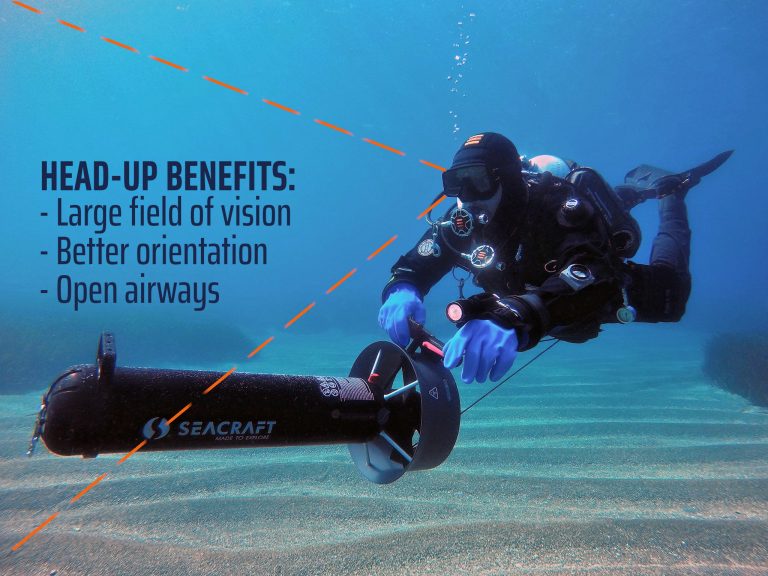DPV DIVER CONFIGURATION
FROM A TO B...
Your diving gear is the foundation for all your dives – or in the words of an experienced diving instructor:
“A dive, that already begins with discomfort, will only get worse.”
Do not stop to strive for improvement. and use whatever makes sense and is affordable for you. In the recent years, the diving industry has seen a series of amazing developments and inventions, and this will go on.
An example:
Modern DPVs (”Diver Propulsion Vehicles”) like the current Seacraft models have evolved from simple underwater toys to efficient, high-tech devices, that not only extend a diver’s range, but support him/her with vital navigation information and trim feedback.
There is plenty of room for improvement for a DPV diver, countless challenges to master and new worlds to discover.
PERFECT BUOYANCY
“Weightlessness” is surely one of the thrills of diving. To achieve it, a DPV diver must have a buoyancy device, that allows him or her to intuitively and subtly control all vertical movements.
Whether you are using a classic ADV (”Adjustable Diving Vest”) or a rather tec-oriented “Donut” (the name derived from its shape) – make sure that your gear does support you.
An example:
A configuration with Donut, backplate and harness (including a crotch belt) will make sure, that your tank will move with you – and not “around” you. Properly adjusted harness and a mandatory crotch strap will make your trip on a scooter more enjoyable – you will lead the scooter and not the opposite.
When your gear starts to feel like an extension of your body (in contrast to a clumsy “backpack”), you are on the right track. Look out for a crotch belt, easy to reach dump valves, streamlined shapes, lots of buoyancy, support on the surface and robust materials.
Everything is connected.
Your buoyancy device will also influence your
trim and your orientation under water. Keep in mind, that the right combination of the tank size and size of your donut / ADV is the key for a comfortable
dive. Your buoyancy can be highly influenced when using a scooter due to big depth amplitudes. Remember to equalise this changes when you stop. Your buoyancy control system must be intuitive and efficient to react immediately.
Our recommendation will be different depending if you are looking for the single-tank wing or double tank donut.

ORIENTATION
Diving means basically, that you constantly move along 3 axes – a genuine “3D experience”. But a safe dive requires you to master even more challenges, including navigation, communication with your buddy, special tasks (e. g. photographing), marine life (that must not be harmed), restricted visibility, currents and much more.
It all begins with how well and how much you can see under water… Keep in mind, that you need to be able to move your head freely in all directions, in order to look ahead, see your buddy and control your instruments.
An example:
The right regulators set and a thorough hose configuration can provide more free space behind your head. The same applies for a streamlined buoyancy device, that supports your hose configuration, thus providing more space behind your head.

MANOEUVRING
Making efficient turns with a DPV requires certain skills – especially if these turns should be precise (for example in narrow caves and wrecks).
Properly selected fins are a handy tool to support diver in such situations. Moving with a scooter gives us extra speed in water. To make precise adjustments or massive turns our fins need to be rigid enough to resist the water-flow.
To maximise your precision on DPV, make sure that you use proper fins, recommended for scooter diving. Best choice is a rigid but quite resilient model. You fins will work like rudder blades in the submarine 🙂

SOLID DPV DIVER - GETTING THERE
For you as a DPV diver, there is only one perfect configuration – the configuration that is perfect for YOU.
Given the vast variety of products in the diving market, selecting the optimal components for your diving gear might seem to be an overwhelming task. But there is hope.
We recommend that you follow a systematic approach and focus on the aspects, that matter most, when you are underwater:
– Trim
– Orientation
– Perfect buoyancy control
Once you have found the perfect wetsuit/dry suit for your dive projects – take a closer look at some other essential parts of your gear. Make a thought through connection between your donut, regulators and fins. It will help you achieve a TOP dive.
In order to find components, that are right for you – don’t hesitate to ask your equipment advisor:
- Inform yourself about a product‘s background (“Why is it made like this?“).
- Dare to ask, if things are not clear to you (“Do I understand this correctly?“).
- Try out as many different products as possible (“How do I feel with it?“)
- Find a buddy/instructor/advisor, you trust and seek his or her advice on how to optimise your configuration (“How am I doing?“).
Article by:
Frank Lemke
Tecline Germany
